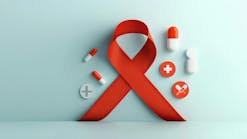Since 2015, only about 1.2 million people have been considered ‘at risk’ of HIV and potentially able to benefit from pre-exposure prophylaxis, also known as PrEP, according to medical literature. These numbers were gleaned by focusing on identifiable populations, such as men who have sex with men and drug users who use needles.
However, the focus on groups of people, rather than on specific behaviors that put people at risk, may cause clinicians considering who might be eligible for HIV screening and PrEP to focus on a particularly narrow population. It could also create a false sense of security to people outside the narrowly defined ‘at risk’ groups. Additionally, this may perpetuate stigmas against certain groups, and perhaps most alarmingly, may result in a gross underestimation of the number of people who could significantly benefit from HIV screening and protection by PrEP.
Sharing needles is a clear and obvious behavior that creates risk of HIV through direct blood-to-blood contact, of course. But it seems like, ‘risk’ gets trickier when it comes to sex and risk. The hard reality is that everyone of any gender or orientation who has vaginal or anal sex even once is at risk for HIV. Even protected sex carries at least some risk for HIV.
In 1991, a survey found that about 40% of young people considered oral sex to be ‘sex,’ but by 2007 and again in 2017, similar surveys found that only about 20% viewed oral sex as ‘sex.’ 1 And when it comes to risk, not all kinds of sex are created equal: the risk of HIV from receptive vaginal sex — receiving the penis in the vagina — is almost exactly twice as high as the risk for insertive vaginal sex - inserting the penis in the vagina. The risk of receptive anal sex is almost 13 times greater than receptive vaginal sex, and although insertive anal sex is about 10 times less risky than receptive anal sex, the risk for uncircumcised insertive anal sex is six times greater than for circumcised insertive anal sex.2
People who have unprotected receptive vaginal or anal sex are generally at the highest risk of contracting HIV and other sexually transmitted diseases, and unprotected receptive anal sex is the riskiest type of sex overall.3 However, this example of the complexity of individual risk illustrates how the complex algorithms currently in use for diagnosis and monitoring can further cloud a clinician’s assessment of what management strategy to pursue.4
Heterosexual anal intercourse increases
For a long time, and still today, anal sex was associated most strongly with men who have sex with men. However, heterosexual anal intercourse (HAI) has become much more common with more than three in ten people reporting having HAI. A survey question from the Centers for Disease Control and Prevention’s (CDC) National Survey of Family Growth showed that about 38% of women reported they had anal sex with a different sex partner in 2017–2019, compared to 33% in 2015–2017. Men stayed consistent at about 38%. See Figure 1.
Women aged 25–29 reported in 2015 to be the population most actively engaging in anal receptive sex in the past month, according to the most recent data available from the 2015 Sexual Exploration in America Study survey.
There are many potential reasons for changes in sexual habits, including more people being open to sexual experimentation, partners seeking to simultaneously avoid pregnancy without contraception, and culturally, some people may feel they are retaining their virginity by engaging in anal sex.
These factors influence the risk paradigm as anal sex is the riskiest type of sex for getting or transmitting HIV.3 All of this could mean that a sexually abstinent drug user who always uses clean needles and a long-time monogamous gay couple who consistently practice safe sex has less risk of HIV than a heterosexual person who has occasional unprotected casual sex. Assigning risk based on membership in an ‘at-risk group’ could easily be both inaccurate and stigmatizing.
So, this begs the question—is it the GROUP that is ‘at risk?’ Or is it specific behaviors that may or may not be practiced by a member of any group, that create a person’s individual risk profile?
HIV transmission
By HIV transmission category, the annual number of HIV infections in 2019, compared with 2015, decreased among males when transmission was attributed to male-to-male sexual contact, but remained stable among all other transmission categories.6
In 2019, the largest percentages of HIV infections were attributed to male-to-male sexual contact, 66% overall and 81% among males. In 2019, among females, the largest percentage of HIV infection was attributed to heterosexual contact at 83%.6
Impact on PrEP use
Pre-exposure prophylaxis can reduce the chance of getting HIV from sex or injection drug use. Unfortunately, routinely used diagnostic tests fail to detect early infection, leading to adverse health outcomes, including delayed antiretroviral treatment, the emergence of INSTI resistance, and on-going HIV transmission.7 Based on this new evidence, the CDC updated the PrEP guidelines to include testing with antigen/antibody (Ag/Ab) and nucleic acid amplification test at every PrEP monitoring visit.4
While strides have been made in the use of PrEP, especially from 2015 to 2020,8 noticeable gaps exist in race, ethnicity and in sex. Black and Hispanic/Latino people account for the majority of people for whom PrEP is recommended, but have the lowest rates of PrEP use among all racial/ethnic groups. PrEP coverage was about three times as high in 2020 among males as among females. Young people ages 16–24 are the least likely to be using PrEP, however, 20% of the new HIV cases are youths 13–24.9
The pool of 1.2 million people who, historically, have been eligible for PrEP is quickly dwarfed when you consider the following:
- 1 in 5 HIV-negative (inferred from HCV study) persons who inject drugs has indications for PrEP.10
- 1 in 200 HIV-negative heterosexually active adults have indications for PrEP, which seem low as statistically half of them are not using condoms.11
- 1 in 4 sexually active HIV-negative adult men who have sex with men have indications for PrEP, which seems low with 70% condomless encounters.11
- 1.3 million incarcerated men in the United States.12
- 3.6 million people inject drugs.13
Perhaps 5 million men between 15–75 would identify as only or predominantly attracted to men, based on an extrapolation of the percentage of men who identify as gay, according to recent Gallup polls, and population estimates.14,15
What can we do?
To be serious about ending the HIV epidemic, it’s critical that everyone who is sexually active know their HIV status, everyone with HIV receive high-quality care and treatment—including an accurate and individualized assessment of their risk profile and counseling about available strategies for protection, including PrEP—and that we end the stigma around HIV and AIDS. These recommendations are similar to those in the National HIV/AIDS Strategy 2022–2025, which has the aim of reducing new HIV transmission by 90% in 2030.16
The CDC recommends that everyone between the ages of 13 and 64 get tested for HIV at least once as part of routine healthcare17 and that anyone who asks for PrEP receives it. Under the Affordable Care Act, most new commercial health insurance plans must cover certain recommended preventive services, including HIV testing for everyone 15 to 65 and other ages at increased risk without additional cost-sharing, such as copays or deductibles.18
We should encourage broader use of HIV screening and use of the preventative, PrEP, not just for specific populations or `at risk groups’ but for individual patients who engage in specific behaviors that put them at increased risk. Healthcare providers need to be willing to engage patients in conversations that really explore risk behaviors, so they can effectively counsel patients on the best ways to protect themselves.
As people who are passionate about public health, we all have a unique role and responsibility, given how vital early and accurate diagnoses are to effectively treating HIV. Ultimately, however, ending the epidemic is not just the job of the doctor, or the government, or nongovernmental organizations…it is everyone’s job.
As laboratorians and clinicians, we must also be advocates for changing the paradigm of ‘at risk group’ to ‘at risk patient’ and make sure that the people who can actually benefit from PreP are identified and supported.
We agree that HIV should become a forgotten disease. Forgotten because we manage to get it onto the rare diseases list, not because we have failed to maintain enough focus and attention to eradicate the epidemic once and for all.
REFERENCES
- Miller K. Most young adults: Oral sex is not sex. WebMD. Published April 8, 2010. Accessed December 22, 2022. https://www.webmd.com/sex-relationships/news/20100408/most-young-adults-oral-sex-is-not-sex.
- Risk of exposure to HIV/AIDS. Stanfordhealthcare.org. Published 2017. Accessed December 22, 2022. https://stanfordhealthcare.org/medical-conditions/sexual-and-reproductive-health/hiv-aids/causes/risk-of-exposure.html.
- Ways HIV can be transmitted. Cdc.gov. Published March 30, 2022. Accessed December 22, 2022. https://www.cdc.gov/hiv/basics/hiv-transmission/ways-people-get-hiv.html.
- Cdc.gov. Accessed December 29, 2022. https://www.cdc.gov/hiv/pdf/risk/prep/cdc-hiv-prep-guidelines-2021.pdf.
- Herbenick D, Bowling J, Fu TJ, Dodge B, et al. Sexual diversity in the United States: Results from a nationally representative probability sample of adult women and men. PLoS One. 2017;20;12(7):e0181198. doi:10.1371/journal.pone.0181198.
- U.S. Statistics. Hiv.gov. Accessed December 22, 2022. https://www.hiv.gov/hiv-basics/overview/data-and-trends/statistics.Eshleman SH, Fogel JM, Halvas EK, Piwowar-Manning E, et al. HIV RNA Screening Reduces Integrase Strand Transfer Inhibitor Resistance Risk in Persons Receiving Long-Acting Cabotegravir for HIV Prevention. J Infect Dis. 2022;13;226(12):2170-2180. doi:10.1093/infdis/jiac415.
- PrEP for HIV Prevention in the U.S. Cdc.gov. Published November 23, 2021. Accessed December 22, 2022. https://www.cdc.gov/nchhstp/newsroom/fact-sheets/hiv/PrEP-for-hiv-prevention-in-the-US-factsheet.html.
- Basic statistics. Cdc.gov. Published June 21, 2022. Accessed December 22, 2022. https://www.cdc.gov/hiv/basics/statistics.html.
- Tassiopoulos K, Bernstein J, Bernstein E. Age and sharing of needle injection equipment in a cohort of Massachusetts injection drug users: an observational study. Addict Sci Clin Pract. 2013;13;8(1):20. doi:10.1186/1940-0640-8-20.
- German D, Nguyen TQ, Ogbue CP, Flynn C. Condomless Anal Intercourse Among Males and Females at High Risk for Heterosexual HIV Infection. Sex Transm Dis. 2015;42(6):317-23. doi:10.1097/OLQ.0000000000000275.
- Correctional populations in the United States, 2013. Bureau of Justice Statistics. Accessed December 22, 2022. https://bjs.ojp.gov/library/publications/correctional-populations-united-states-2013.
- Bradley H, Hall E, Asher A, Furukawa N, et al. Estimated number of people who inject drugs in the United States. Clin Infect Dis. 2022;6:ciac543. doi:10.1093/cid/ciac543.
- Population of the U.S. by sex and age 2021. Statista. Accessed December 22, 2022. https://www.statista.com/statistics/241488/population-of-the-us-by-sex-and-age/.
- Newport F. In U.S., estimate of LGBT population rises to 4.5%. Gallup. Published May 22, 2018. Accessed December 22, 2022. https://news.gallup.com/poll/234863/estimate-lgbt-population-rises.aspx.
- National HIV/AIDS Strategy (2022-2025). Hiv.gov. Accessed December 22, 2022. https://www.hiv.gov/federal-response/national-hiv-aids-strategy/national-hiv-aids-strategy-2022-2025.
- HIV testing. Cdc.gov. Published June 9, 2022. Accessed December 22, 2022. https://www.cdc.gov/hiv/testing/index.html.
- The Affordable Care Act and HIV/AIDS. Hiv.gov. Accessed December 22, 2022. https://www.hiv.gov/federal-response/policies-issues/the-affordable-care-act-and-hiv-aids.






